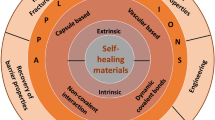Abstract
Purpose
Although grafts can be made from the same materials, the final weave of the product may play a role in the ultimate outcomes or complications. The aim of this experimental study is to evaluate and compare the mechanical properties of the meshes and their influence on biological characteristics as well.
Methods
Full-thickness abdominal wall defect with respect to the peritoneum was primary repaired in 144 male Wister rats using the overlay technique. Monofilament, multifilament and coated polypropylene grafts were used for the repairs. Graft shrinkage, thickness and tensile strength of the explants were analysed after 3 and 6 weeks.
Results
Monofilament grafts showed the highest shrinkage level of 11.97–18% during the investigated period. The thickness of monofilament explants increased gradually, with a maximum of 25.35% after 6 weeks. Multifilament and collagen explants did swell more rapidly in the third week, decreasing thereafter to 19.63–23.04% above the pre-implantation values after 6 weeks. The tensile strength showed a gradual increase over the course of the experiment in all groups.
Conclusion
After graft stabilisation, all samples had similar strength, regardless of the significant differences in the pre-implantation values of graft strength.




Similar content being viewed by others
References
Dietz HP, Vancaillie P, Svehla M, Walsh W, Steensma AB, Vancaillie TG (2003) Mechanical properties of urogynecologic implant materials. Int Urogynecol J Pelvic Floor Dysfunct 14:239–243
Afonso JS, Martins PALS, Girao MJBC, Natal Jorge RM, Ferreira AJM, Mascarenhas T, Fernandes AA, Bernardes J, Baracat EC, Rodrigues de Lima G, Patricio B (2008) Mechanical properties of polypropylene mesh used in pelvic floor repair. Int Urogynecol J Pelvic Floor Dysfunct 19:375–380
Abdel-Fattah M, Sivanesan K, Ramsay I, Pringle S, Bjornsson S (2006) How common are tape erosions? A comparison of two versions of the transobturator tension-free vaginal tape procedure. BJU Int 98(3):594–598
Hefni M, Yousri N, El-Toukhy T, Koutromanis P, Mossa M, Davies A (2007) Morbidity associated with posterior intravaginal slingplasty for uterovaginal and vault prolapse. Arch Gynecol Obstet 276:499–504
Ignjatovic I, Basic D, Stosic D, Potic M, Mitic P, Milic V (2008) Reutilization of the Prolift mark system for the simultaneous correction of prolapse and incontinence in patients with pelvic organ prolapse and stress urinary incontinence. Eur J Obstet Gynecol Reprod Biol 141(1):79–82
Johnson & Johnson (2003) Nonabsorbable prolene soft mesh. Gynecare Gynemesh PS: p 2
Konstantinovic ML, Pille E, Malinowska M, Verbeken E, De Ridder D, Deprest J (2007) Tensile strength and host response towards different polypropylene implant materials used for augmentation of fascial repair in a rat model. Int Urogynecol J Pelvic Floor Dysfunct 18:619–626
Amid PK (1997) Classification of biomaterials and their related complications in abdominal wall hernia surgery. Hernia 1:15–21
Walid MS, Agarwala N, Heaton RL (2009) Laparoscopic removal of infected mesh colposacropexy. Arch Gynecol Obstet 280:103–106
Deprest J, Zheng F, Konstantinovic M, Spelzini F, Claerhout F, Steensma A, Ozog Y, De Ridder D (2006) The biology behind fascial defects and the use of implants in pelvic organ prolapse repair. Int Urogynecol J Pelvic Floor Dysfunct 17(Suppl 1):S16–S25
Krause H, Bennett M, Forwood M, Goh J (2008) Biomechanical properties of raw meshes used in pelvic floor reconstruction. Int Urogynecol J Pelvic Floor Dysfunct 19:1677–1681
de Almeida SHM, Rodrigues MAF, Gregório E, Crespígio J, Moreira HA (2007) Influence of sling material on inflammation and collagen deposit in an animal model. Int J Urol 14:1040–1043
Klinge U, Conze J, Limberg W, Brücker C, Ottinger AP, Schumpelick V (1996) Pathophysiology of the abdominal wall. Chirurg 67:229–233
Bringman S, Conze J, Cuccurullo D, Deprest J, Junge K, Klosterhalfen B, Parra-Davila E, Ramshaw B, Schumpelick V (2010) Hernia repair: the search for ideal meshes. Hernia 14:81–87
Khan LR, Liong S, de Beaux AC, Kumar S, Nixon SJ (2010) Lightweight mesh improves functional outcome in laparoscopic totally extra-peritoneal inguinal hernia repair. Hernia 14:39–45
Junge K, Klinge U, Prescher A, Giboni P, Niewiera M, Schumpelick V (2001) Elasticity of the anterior abdominal wall and impact for reparation of incisional hernias using mesh implants. Hernia 5:113–118
Neumeyer J, Abdul-Wahab W, Beer M, Speethman J, Groneberg D, Große-Siestrup C (2007) Laboratory testing of suburethral mesh slings: a comparison of their static and dynamic properties. Int Urogynecol J 18(Suppl 1):S111
Sergent F, Desilles N, Lacoume Y, Bunel C, Marie JP, Marpeau L (2009) Mechanical evaluation of synthetic biomaterials used in the correction of pelvic floor disorders—experimental study in rabbits. Eur J Obstet Gynecol Reprod Biol 147:106–110
Fung YC (1993) Biomechanics: mechanical properties of living tissues, 2nd edn. Springer, Berlin
Greca FH, Souza-Filho ZA, Giovanini A, Rubin MR, Kuenzer RF, Reese FB, Araujo LM (2008) The influence of porosity on the integration histology of two polypropylene meshes for the treatment of abdominal wall defects in dogs. Hernia 12:45–49
Acknowledgements
We are grateful to the Institute for Biomedical Research of the Faculty of Medicine, University of Nis, where the experimental study took place.
Conflict of interest
The authors declare that they have no conflict of interest.
Author information
Authors and Affiliations
Corresponding author
Rights and permissions
About this article
Cite this article
Potic, M., Ignjatovic, I., Savic, V. et al. Mechanical properties and tissue reinforcement of polypropylene grafts used for pelvic floor repair—an experimental study. Hernia 15, 685–690 (2011). https://doi.org/10.1007/s10029-011-0829-6
Received:
Accepted:
Published:
Issue Date:
DOI: https://doi.org/10.1007/s10029-011-0829-6




